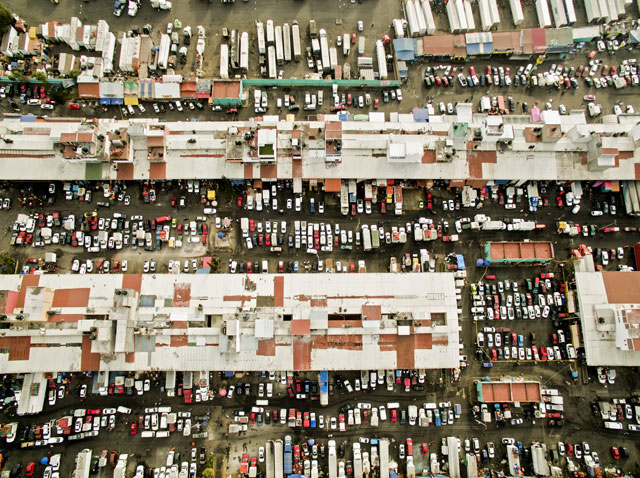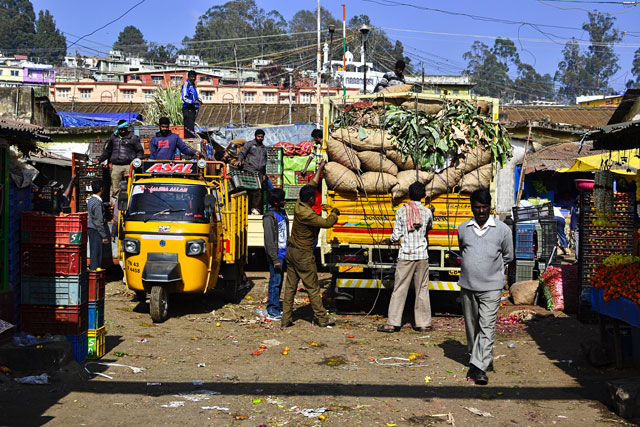
This is part two of our series on urban freight and achieving a “triple zero” bottom-line: zero emissions, zero road deaths and zero exclusion from core services and opportunities.
Left unchecked, urban freight will continue to be a major driver of the global climate crisis. Transport is responsible for 14% of the planet’s greenhouse gas emission sources, 40% of which comes from freight. Getting the sector to zero emissions requires a quiver of solutions ranging from battery-electric trucks to completely transforming the way cities move and receive goods.
China’s Bet on Electric Vehicles
China has recognized the enormity of freight’s share in its national emissions. According to Liu Ying, a director at the Beijing Transport Institute, trucks constitute only 6% of all vehicle types in Beijing but are responsible for more than half of major vehicle emissions. In 2019, freight and passenger vehicles in the country emitted almost 41 million tons of pollutants, including particulate matter and nitrogen oxides.
The problem, Ying says, is that China relies too much on diesel trucks. Eighty one percent of goods in China, from small electronics to raw ore, move by truck. By comparison, trucks in the U.S. move 65% of freight volume, and in the European Union, 75%. The rest is handled by a combination of rail, air, pipeline and barges.
Beijing is taking ambitious steps to cut freight emissions with a two-fold strategy: put heavy goods on rail and then incentivize electrification of light-duty freight vehicles through a combination of electric vehicle (EV) purchase subsidies and permitting. Beijing’s city access permits now require all daytime deliveries to be made by zero- or low-emission trucks, for example.
The plan has largely been a success. Between 2017 and 2019, Beijing shifted 3 million tons of goods to rail, Ying says, replacing 250,000 truck trips and saving 1.5 million tons of carbon dioxide. Meanwhile, nationwide, manufacturers sold roughly 200,000 electric light-duty freight vehicles in 2017, about 6% of the market for light-duty trucks. By the end of 2020, 90% of China’s light-duty freight vehicles with city access permits will be electric.
China’s re-orientation around light-duty vehicles comes as EVs become more affordable. By 2024, the lifetime cost of owning an electric truck will be lower than owning a conventional diesel truck, and major companies are cashing in. Amazon, for example, has announced plans to purchase 100,000 electric delivery vans by 2030. This EV purchase represents the single largest by one company and would nearly double the number of electric trucks operating in the U.S. and Europe today.
Freight electrification appears to be right at our doorstep. So, what’s standing in the way?
Optimize Now. Electrify Next.
In 2005, FedEx set a target to improve fuel efficiency by 50% by 2025. It has achieved 40% of this goal by optimizing routes, consolidating loads and choosing the right-sized vehicles for the job, says Boris Kort-Packard, chief engineer for FedEx. “To reach that last 10%,” he says, “will require a significant amount of electrification.”
Unfortunately, the charging infrastructure necessary to support that shift is not in place in many locations where the company operates, Kort-Packard says. Charging infrastructure is pricey, in the ballpark of hundreds of millions of dollars to accommodate around 10,000 delivery trucks. Add in the higher upfront price tag for EVs, their shorter driving ranges and added stress to the power grid, and it makes complete electrification an uphill battle. But not an unwinnable one.
Some of these hurdles can be lowered with data. “Data sharing is critical for policies to work and companies to reduce emissions,” says Sophie Punte, executive director of the Smart Freight Centre. “A big problem is that there’s no common methodology to account for freight emissions.”
The Smart Freight Centre developed the Global Logistics Emissions Council Framework for measuring companies’ freight emissions. Understanding carbon footprints enables companies to make data-driven decisions to improve efficiency, adapt to regulations and take advantage of sustainability incentives. As the side effects of cleaner vehicles – as well as the costs of dirtier fuels – get more attention, it’s more valuable for companies to understand the full impact of their activities.

Using data to optimize deliveries is particularly important in countries with poor energy access, large informal freight economies or highly polluting power grids. In some cases, these countries might not be ready to transition fully to EVs, but fewer trips and increased efficiency means fewer emissions, regardless of vehicle type.
Some companies in these countries are getting the ball rolling by using apps to connect truck drivers to help them optimize routes and pool loads. Others are seizing low-cost electrification opportunities where they can. For instance, startups in Kampala, Uganda, are electrifying motorcycle deliveries by retrofitting motorcycles with recycled laptop batteries.
Leadership from governments can help incentivize change by setting targets and rewarding good behavior. The California Air Resource Board recently adopted a rule that requires 60% of new trucks sold in the state to be zero-emission by 2035, offers rebates for buyers, and creates a market for up to a half-million electric trucks 20 years from now.

Your Climate Solution Arrives Tonight
Global greenhouse gas emissions must fall 8% each year starting now if we are to keep global temperature increases under 2 degrees Celsius, a threshold beyond which scientists warn of dangerous repercussions. To meet the ambitions of the Paris Climate Agreement, Sita Holtslag from the Transport Decarbonisation Alliance urges governments to start with freight.
“It’s not just about replacing every vehicle in the city with electric vehicles,” says Holstslag, who recently authored a white paper on zero-emission urban freight. We need to eliminate as many trucks as we can now, she says, then electrify what’s left.
Jose Holguin-Veras, a civil engineering professor at Rensselaer Polytechnic Institute, says immediate adjustments in logistics can go a long way. For one recent project, Holguin-Veras monitored trucks during their usual daytime delivery routes in New York City. One truck in particular would make a daily 16-mile detour to avoid the Manhattan gridlock.
But by delivering during off-hours before congestion was at its peak, Holguin-Veras found trucks could cut delivery times and greenhouse emissions by up to 67%, a potential savings of 2.5 million tons of carbon dioxide from the New York area every year. São Paulo, Bogotá and Addis Ababa have piloted similar off-hour delivery programs with emissions savings too.

Moonlit deliveries could save carriers a fortune too. In 2018 alone, four major shippers – including FedEx and UPS – paid New York City a collective $27 million in daytime parking fines.
Carriers want better logistics, and better logistics means fewer emissions. But carriers are also ultimately at the mercy of customers, from businesses to individual consumers, who might not see the point of accommodating nighttime deliveries. Successfully pulling off an off-hour delivery program therefore means building relationships with the people it affects most: us.
Holguin-Veras urges cities to reach out to restaurant, store owners and community members, not just the people who drive the trucks. “They have a lot to say on how deliveries are made.”
As cities grow and demand for urban freight grows too, it’s clear these systems can no longer be a secondary issue for decision-makers. The efficient distribution of essential goods, the safety and accessibility of city streets, our zero-carbon future – these goals are impossible without integrating urban freight into our vision of sustainable urban mobility and a better city.
Travis Fried is a Research Analyst for Urban Mobility at WRI Ross Center for Sustainable Cities.
Eleanor Jackson is a Research & Communications Assistant for the Global Electric Mobility team at WRI Ross Center for Sustainable Cities.
Ben Welle is Director of Integrated Transport & Innovation at WRI Ross Center for Sustainable Cities.
Sergio Avelleda is Director of Urban Mobility at WRI Ross Center for Sustainable Cities.






